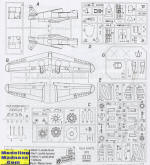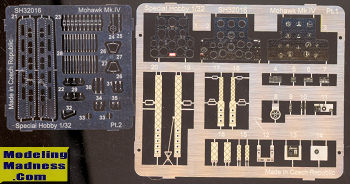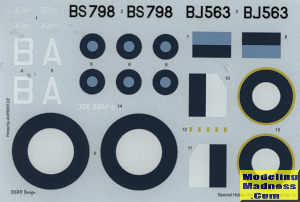
Special Hobby 1/32 Mohawk IV
| KIT #: | SH 32016 |
| PRICE: | $40.00 Delivered |
| DECALS: | Two options |
| REVIEWER: | Scott Van Aken |
| NOTES: |

| HISTORY |
The Curtiss Mohawk IV was the most numerous version of the Hawk 75 to enter RAF service, and saw front line service with the RAF in India and with the South Africa Air Force in East Africa.
The RAF's Mohawk IVs came from at least three different sources. The majority of them were part of a French order for 795 Hawk H75A-4s. These were powered by a 1,200hp Wright R-1820-G205A Cyclone engine, replacing the Pratt & Whitney engines of the earlier French aircraft and the Mohawk I, II and III. They were armed with six 7.5mm guns, two in the nose and four in the wings.
A total of 284 aircraft were completed to this specification. Of these aircraft six reached France, four were lost at sea and twenty three were sent to Martinique, where they sat out the war. This left 251 that were taken over by the RAF, given British equipment and the designation Mohawk IV. They were joined by ten H75A-9s built for Persia, and at least six H75A-5s that were to have been built under licence in China but that were actually completed in India. This gives a total of 266 aircraft, although RAF records suggest that there were a total of 278 Mohawk IVs.
The Mohawk IV was not seen as suitable for service with the RAF in Britain. A number were given to Portugal, and more to the South Africa Air Force, but a significant number did see service with the RAF, operating over Burma from bases in India. In the RAF and SAAF cases, these planes were often succeeded by Hurricanes and used as trainers once their operational use was over.
| THE KIT |
 Special
Hobby has done at least four boxings of the P-36/Hawk 75/Mohawk so a lot of the
sprues are common to all variants. The major difference in the Mohawk four is
the engine and the cowling section as most of these aircraft were fitted with
the smaller, but longer R-1835. Thanks to the commonality of sprues, there are
parts provided that are not used in this build.
Special
Hobby has done at least four boxings of the P-36/Hawk 75/Mohawk so a lot of the
sprues are common to all variants. The major difference in the Mohawk four is
the engine and the cowling section as most of these aircraft were fitted with
the smaller, but longer R-1835. Thanks to the commonality of sprues, there are
parts provided that are not used in this build.  As
you might expect, there is a significant photo etch suite with the majority of
the parts being used either in the cockpit or as part of the assembly of the
bomb racks under the wing. Bits that would be Lilliputian in other scales are
manageable in 1/32 with some being integral to the build so cannot really be
left off. You are provided a full color instrument panel and a seat harness as
well as various switches and levers for the cockpit. This pretty much makes up
the large fret on the right of the image. The other, smaller fret is mostly for
the underwing bomb racks. The kit also supplies some small resin pieces. These
are wing gun barrels, part of the gun sight, and the gearing pieces for the
landing gear.
As
you might expect, there is a significant photo etch suite with the majority of
the parts being used either in the cockpit or as part of the assembly of the
bomb racks under the wing. Bits that would be Lilliputian in other scales are
manageable in 1/32 with some being integral to the build so cannot really be
left off. You are provided a full color instrument panel and a seat harness as
well as various switches and levers for the cockpit. This pretty much makes up
the large fret on the right of the image. The other, smaller fret is mostly for
the underwing bomb racks. The kit also supplies some small resin pieces. These
are wing gun barrels, part of the gun sight, and the gearing pieces for the
landing gear. 
| CONCLUSIONS |
The Mohawk was really only a footnote in WWII Allied fighter history, but did perform well when it was put to the test. This kit should make into a very nice model and will look great next to its P-40 sibling.
| REFERENCES |
http://www.historyofwar.org/articles/weapons_curtiss_mohawk_IV.html
June 2019 Copyright ModelingMadness.com. All rights reserved If you would like your product reviewed fairly and fairly quickly, please contact the editor
or see other details in the
Note to
Contributors. Back to the Main Page
Back to the Review
Index Page
Back to the Previews Index Page